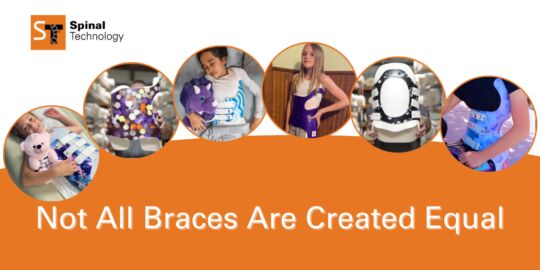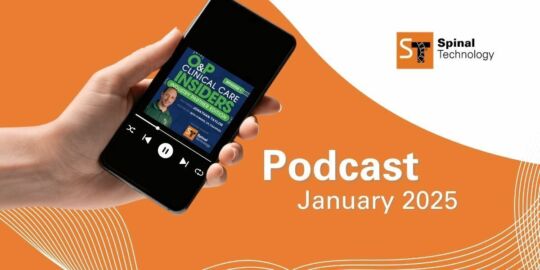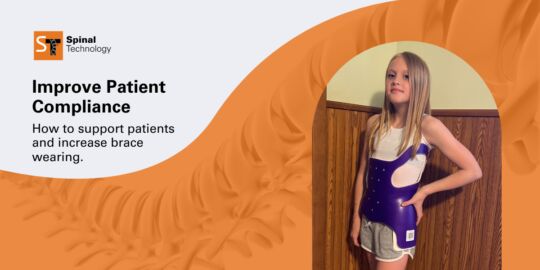Variations of Scoliosis Brace Design

If we look back first at what is a brace, and really a scoliosis brace, it's a plastic shell, and that shell is just a frame to hold mechanical forces. There's nothing more to it, the shape of that shell and how it's cut out and constructed all it is just an anchoring point, and it's a structure for holding these corrective forces beyond that.
Scoliosis is a lateral deviation and axial rotation, and the only way to bring that back into balance are going to be specific force vectors that de rotate and medially translate. And there are more efficient force vectors that can accomplish that, but you have the capability in just about any most brace types anyway, to affect that. So if you go back years before bracing, and you look at traction devices, where you'd have a wooden framework with straps and pulleys, and a patient would sit down all day, those straps and pulleys are applying a certain force factor that's de rotating medially translating in there, correcting the deformity mechanically. That's all we're doing within a brace. The variations among the braces come down to some specifics in how we address our sagittal alignment and our balance. That's really where the differences end.
We have to go back to the basics of brace design and the mechanics of how bracing works in order to really understand what a brace is. Clinicians around the world tend to get confused with different names and types with all the nuances and features that they think really add some significant clinical advantage, when in reality, there's nothing out there that really has demonstrated anything above and beyond the other bracing types.
There's so many variations on these scoliosis braces. There has to be one that is just the best, right? There's got to be a simple one stop answer that covers the whole spectrum?
That's the ultimate question from orthotists all across the globe. You may find a handful of experts that will say they know the answer to that. But in reality, there is no solid answer to that. Instead what we have is a great deal of misunderstandings or misconceptions about various brace styles and types. If you read through the literature, there is nothing in science and research that can demonstrate clear superiority of any one type of brace over another. So there's a lot more similarities among bracing types than there are differences.
So what does the research tell us?
Over the years, much research has been conducted on the effectiveness of bracing. A single search query on PubMed for “adolescent idiopathic scoliosis brace” returned a net result of 1,367 articles. Throughout O&P, one of the most sought-after answers has become “which brace is best?” With a dramatic increase in the frequency of published papers, it can be challenging to make sense of it all. It’s important to recognize that the reported success of any specific brace type can vary significantly depending on which related study is reviewed. The discrepancies in outcome data across existing literature can likely be attributed to a myriad of factors involving any component of a study; from its design and protocols to the quality of the brace fabrication, or from the clinical team’s level of expertise to the patient’s brace wearing compliance.
Additionally, a high risk of bias throughout much of the research available exists. The magnitude of this discrepancy has been well documented and defined. The most notable of literature reviews is a 2021 article by Costa et al. [1], evaluating research published on various brace types. They strongly note “The majority of brace studies have significant risk of bias”[1]. That paper also noted previous reviews, including a 2018 paper stating, “The vast majority of the studies had a moderate to high risk of bias, as also shown by Negrini et al. in their review and SOSORT guidelines [8,18]”[2,3].
To answer the question of best brace type, the growing consensus is that the answer does not exist, nor likely will it. What is becoming more widely accepted is that any brace can be effective and just as effective as any other. The most impactful variables in outcomes relate to the skill and expertise of the clinician, the quality of brace fabrication and, most significantly, patient compliance. This is likely our biggest challenge. As a result of this understanding, the inclusion of an objective method of measuring for compliance with technological advancements, such as the stWear® Compliance Monitoring System, has had a dramatic increase in the rate of adoption in recent years. This has also become an important component of any bracing research, as identified in the guidance of study design by the SRS.
However, as for bracing effectiveness by type, some answers have come to light, not in superiority of outcomes, but in that of similarity. There has been a growing level of evidence and acceptance of nocturnal bracing, such as the Providence Nocturnal Scoliosis® Orthosis, as a comparable alternative to full-time bracing. While the corrective mechanics are mostly consistent with other brace designs, the hyper-corrective ability of nocturnal braces can often produce a significantly greater degree of correction. Worn when most of the growth is occurring, the brace can achieve comparable outcomes in a shorter period of wear time. This is magnified by the increase in rates of compliance, due to being worn in the privacy of a patient's home and only when lying down, among other reasons. Considering these outcome findings, the improvement in a patient’s quality of life and the psychosocial impact of brace wear, there are quite compelling reasons for considering nocturnal bracing for many patients.
1. Costa L, Schlosser TPC, Jimale H, Homans JF, Kruyt MC, Castelein RM. The Effectiveness of Different Concepts of Bracing in Adolescent Idiopathic Scoliosis (AIS): A Systematic Review and Meta-Analysis. J Clin Med. 2021 May 15;10(10):2145. doi: 10.3390/jcm10102145. PMID: 34063540; PMCID: PMC8156678.
2. Negrini S, Donzelli S, Aulisa AG, Czaprowski D, Schreiber S, de Mauroy JC, Diers H, Grivas TB, Knott P, Kotwicki T, Lebel A, Marti C, Maruyama T, O'Brien J, Price N, Parent E, Rigo M, Romano M, Stikeleather L, Wynne J, Zaina F. 2016 SOSORT guidelines: orthopaedic and rehabilitation treatment of idiopathic scoliosis during growth. Scoliosis Spinal Disord. 2018 Jan 10;13:3. doi: 10.1186/s13013-017-0145-8. PMID: 29435499; PMCID: PMC5795289.
3. Negrini S, Minozzi S, Bettany-Saltikov J, Chockalingam N, Grivas TB, Kotwicki T, Maruyama T, Romano M, Zaina F. Braces for idiopathic scoliosis in adolescents. Cochrane Database Syst Rev. 2015 Jun 18;2015(6):CD006850. doi: 10.1002/14651858.CD006850.pub3. PMID: 26086959; PMCID: PMC10616811.


